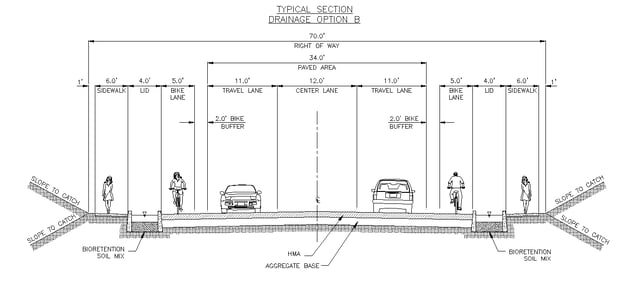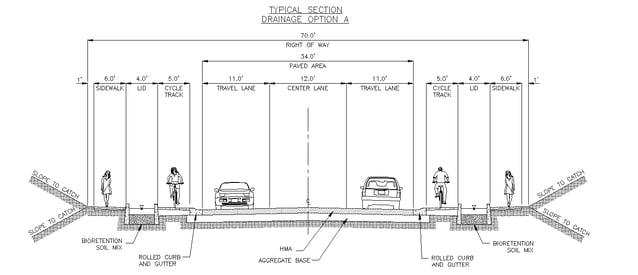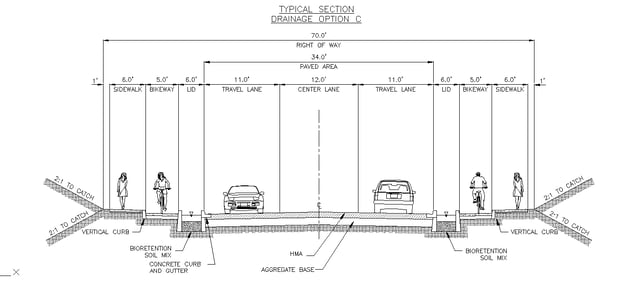
This post is the second in a three-part series covering a new alternative being considered for street sections: the separated bike lane. The first post outlined the basic concepts and the three options available for how bike lanes can be separated. This post will cover the challenges and opportunities related to low impact development (LID) stormwater.
As discussed in our first post, there are three main options to choose from when considering a separated bike lane facility: buffered, raised, and protected. Before you make your choice, it is important to consider the stormwater implications of each, because all these options will likely create more impervious area than a standard section with on-street bike lanes.
We are going to limit our discussion to low impact development (LID) water quality measures, specifically the two most common measures for roadways – rain gardens (bio-retention) and pervious/permeable pavement – since these are fast becoming the norm and are already required in many areas. As you will see, each option has different implications for LID stormwater treatment.
Buffered Bike Lanes (Horizontal Shift)

Buffered bike lanes feature a wider paint stripe (typically 2 feet wide) between the vehicle and bicycle lanes. From a stormwater perspective, the buffered bike lane is no different than the standard bike lane except that there is more impervious area. This means that you will have to treat the runoff from the bike lanes the same as that from the vehicle lanes.
The use of rain gardens is easily achievable with this option by installing curb cuts. The buffered bike lane comes at a cost with its wider roadway section (this option leads to the largest increase in impervious surface in most cases), but the use of curb cuts to allow direct discharge of stormwater into a bio-retention facility helps offset the cost by reducing the need for pipe, inlets, and manhole structures.
Pervious pavement is typically not an option with this configuration because the bike and vehicular lanes are part of the same continuous pavement section.
Raised Bike Lanes (Vertical Shift)

The raised bike lane, or cycle track, is likely to create additional impervious area (although not nearly as much as a buffered bike lane) when a wider rolled curb is used, which is standard. Because the bike lanes typically slope back toward the vehicle lanes, the runoff gets mixed and must all be treated as if it came from the vehicle lanes.
Rain gardens can be used with raised bike lanes. However, the grade separation does not allow for continuous inflow entry to a bio-retention facility, so a more complex geometric design is needed to avoid trapping water or creating flat spots prone to ponding, particularly if the roadway profile is flat. Inlets are needed at the low point between the vehicle and bike lanes, and then the stormwater must be piped to the facility. The fact that the road is lower also means the rain garden must be deeper than normal. This combination of pipes, inlets, and deeper bio-retention facilities leads to increased costs. However, the additional costs can be at least partially offset by savings from a narrower road section and constructing the raised bike lane similar to an attached sidewalk.
Another LID option is to construct the raised bike lanes with permeable pavement. This would treat and infiltrate runoff from the bike lanes, but runoff from the vehicle lanes would still need to be handled in a separate facility, so while this is a viable approach, it can be somewhat expensive.
Protected Bike Lanes

The primary benefit of a protected bike lane from a stormwater perspective is that runoff from the bike lane does not mix with runoff from the vehicle lane. This can be extremely beneficial in jurisdictions that consider the bike/pedestrian area a non-pollution generating surface (although some jurisdictions will still require it to be treated like water from the roadway). Plus this option also leads to the smallest increase in impervious surface.
The protected bike lane configuration can easily support curb cuts for rain gardens in either a continuous inflow or point load entry. This eliminates the need for inlets, manholes, and conveyance pipe. Protected bike lanes also can be built similar to a sidewalk and allow you to reduce the roadway width, both of which lower costs.
Pervious pavement can be a good LID choice when using protected bike lanes. However, be aware that maintenance could be tricky, as the width of the bike lane will not accommodate a standard street sweeping vehicle, which is what many agencies prefer to keep permeable pavement clean and functioning properly.
Conclusion
There’s no one-size-fits-all roadway section. Projects must be designed on a case by case basis for best results. If you’re considering separated bike lanes for one of your projects, understand that each option carries different stormwater implications. Considering these, along with external stakeholder input, Complete Streets initiatives, and other design considerations is essential for overall project success.
Stay tuned for our final post in this series, which will discuss how to accommodate separated bike lanes at intersections.
What do you think about separated bike lanes? How have you handled stormwater control when you’ve used them? Please leave a comment and let me know.
Image credit: Adobe Stock / peerawat444

